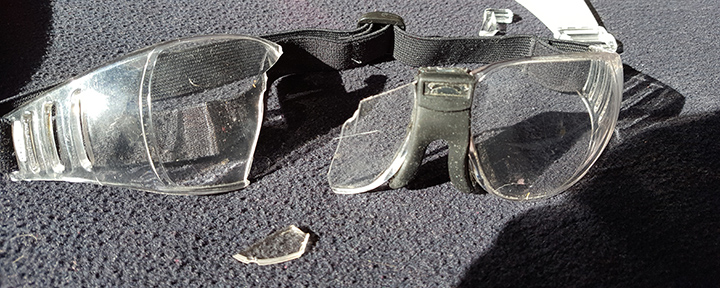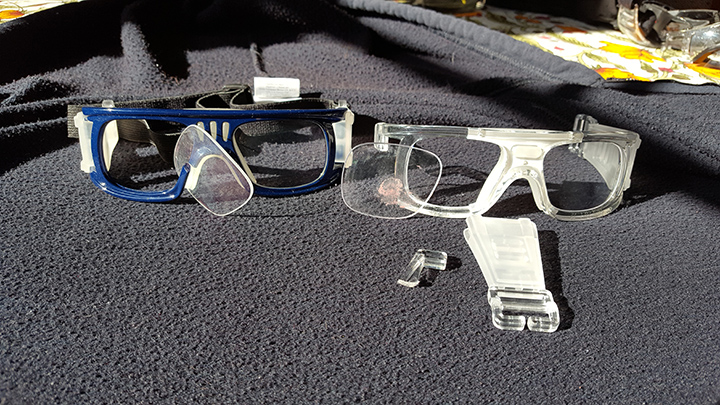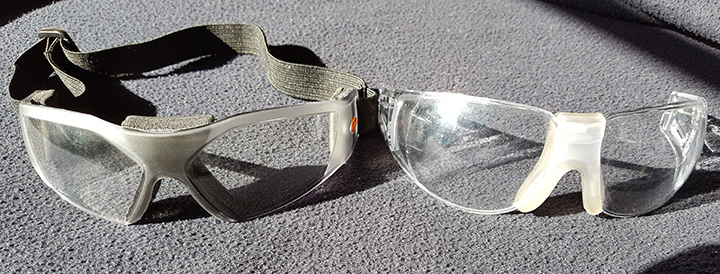Study of Protective Eyewear for Handball – Phase Two Update

Study of Protective Eyewear for Handball Summary of Phase Two
Principal Investigators: Benjamin Schmid, David Steinberg, Jeff Kastner
February 9, 2017
The purpose of this phase two study was to test six more types of protective eyewear using the same methodology as for phase one, already documented on the USHA website. Both phase one and phase two research will be used to create a new handball specific standard for review and approval by the American Society of Testing and Materials, ASTM International. The laboratory at Pacific University’s College of Optometry, Forest Grove, Oregon campus was used again with the same basic testing apparatus, tools and equipment except a different high speed camera, the Edgertronic SC1. Additionally, “ballistic paste” (red lipstick) was used on the pressure sensor to determine the approximate surface area of eye contact; sensor operation was not affected in any way.
Tested Models
The following protective eyewear models tested were:
1. Revision military grade SawFly, donated by Fred Penning
2. BangerZ model HS-2000, purchased by the USHA eyeguard fund
3. BangerZ model HS-5500, purchased by the USHA eyeguard fund
4. Roca model TP456 for basketball, donated by Steve Birrell, USHA board member
5. Panlees JH0025 for basketball, donated by Steve Birrell, USHA board member
6. ZLeader Champion model, donated by David Steinberg
Study Design and Details
This study simulated how these sample eyewear products react to being struck by a handball using data obtained from high speed video and a force measuring system. Three “shots” are done while collecting data from the video and force measurement equipment for each eyewear model. All shots were direct frontal impact targeting the manikin eye at speeds of 50, 65 and 80 MPH.
Eyewear that fails on any shot will be deemed unsafe and no further testing will be done on that model. For the purposes of this study, the criteria of failure is: any detectable eye contact or any broken and/or cracked unit.
Model Results Summary
 Image 1 (Z Leader Champion). Image 1 (Z Leader Champion). |  Image 2 (Roca TP456 & Panlees JH0025). Image 2 (Roca TP456 & Panlees JH0025). |  Image 3 (BangerZ HS-5500 & HS-2000). Image 3 (BangerZ HS-5500 & HS-2000). |
Revision SawFly: This model failed on a 50mph shot with measurable direct eye contact of the lens as it flexed inward from convex to concave. This action, referred to as the “oil can effect”, was been previously documented in phase one.
ZLeader Champion: This model failed on a 50mph shot by cracking into several pieces. See Image 1.
Roca TP456: This model failed on a 50mph shot by suffering a cracked frame and lens ejection. See Image 2.
Panlees JH0025: This model fail on a 50mph shot suffering a cracked frame, broken pieces and lens ejection with the lens contacting the eye with measurable force and ballistic paste present. See Image 2.
BangerZ HS-2000: This model PASSED all three shots at all three speeds. See Image 3.
BangerZ HS-5500: This model PASSED all three shots at all three speeds.
Conclusions
The investigators’ interpretation of the video and data shows that there are at least two commercially manufactured eyewear models that offer protection from direct shots to the eye. In addition, David Steinberg has been using the BangerZ HS-5500 since the study was conducted and reports that the unit is very comfortable, has great vision and does not fog up. Part of the reason for this is the larger and softer padding that creates a bigger air gap between the lenses and face. The manufacturer has been contacted to discuss modification to the padding used to further increase protection and comfort.
Given the results of two passing models, it is hoped the USHA will give precedence to making these available for sale and remove the two models currently marketed that already failed phase one testing.
Lastly, the research team requests any USHA member to join us to provide insight and input to the creation of a new, handball specific, ASTM standard.
Contact David Steinberg.
Phase One Study
The accompanying “Study of Protective Eyewear for Handball” was conducted last winter at Pacific University. Principal investigators were Benjamin Schmid and David Steinberg. Consultants were Karl Citek, MS, O.D., PhD, and Professor Fraser Horn, O.D., chairman of the Sports Vision Council of the American Optometric Association. Videographer was Jeff Kastner.
See the unabridged Study for Protective Eyewear for Handball report HERE.
If interested in providing feedback for the ASTM subcommittee to write a standard for handball CLICK HERE.
The purpose of the study in March was to test the efficacy of several common types of protective eyewear used for handball.
The laboratory at Pacific University’s School of Optometry in Forest Grove, Ore., was the site for the study. The lab offered the basic testing apparatus, tools and equipment, and several professors of optometry provided expert opinion, oversight, comments and feedback to the experimental design and testing process.This study simulated how sample eyewear products react to being struck by a handball and observed effects on eye anatomy using data obtained from high-speed video and a force-measuring system.There are numerous variables to consider testing in a dynamic sport like handball. The investigators chose three to control: launch velocity, impact angle and ball type. Three “shots” are done for each variable while collecting data from the video and force-measurement equipment for each eyewear model.
To be effective, eyewear must be able to prevent direct ball contact with the globe, lessen and disperse the impact energy, remain intact and in place, fit comfortably and minimize view obstruction.
In handball, the risk for globe injury from indirect impact is higher than direct impact for two reasons:
- The facial area — temple and nose bridge — where forces can be transmitted to the globe is larger than the eye socket.
- In player positioning, the exposed player is most often looking back from an angle.
The design of this study to include indirect impacts was initiated because of recent injuries of this nature that caused permanent vision loss. Interestingly, side and angled impact studies are noticeably absent from the body of research, though this mechanism of injury and associated trauma is well documented.
The testing equipment consisted of a Plexiglas enclosure containing the standard Canadian head form for the average adult male fixed on an adjustable mount. The ball was launched through an aperture in the Plexiglas from a Juggs gun over a light-sensitive chronograph to measure velocity. Data from each impact was collected from two sources: an ultra-high-speed camera and a force-sensor system. The camera was the Phantom V711 rented from Vision Research1, the manufacturer. It was configured to operate at 20,000 frames per second using a 50mm lens and mounted about 1 foot from the mannequin with an essential field of view of about 6 square inches perpendicular to the trajectory of the ball.
The sensor unit was the Tekscan multi-handle high-speed ELF system with three thin film transducers connected via three USB ports to a Windows-based computer.The ELF software can record up to 6,000 force reading per second with an upper limit of 1,000 pounds for each transducer. The transducers are mounted on the mannequin under the eyewear on the inside nose bridge, the temple and the eye.
The following parameters chosen for the study were: launch velocities of 50 mph, 65 mph and 80 mph, and impact angles with the mannequin of 0 degrees (frontal impact), 90 degrees (side impact) and 115 degrees (angled impact).
The vast majority of adult players routinely hit the Red 21 ball at 50 mph. All handball specifications are available on the USHA’s website.
Four commercially available eyewear models were tested — two sold by the USHA, one sold by Edtl Handball and the other by O’Neills.
The USHA models are the Blacknight Turbo and Racket-Specs, both manufactured by Unique Sports Inc. and passed the ASTM F803 standard in 1998.
The Edtl Handball model is called the Edtl Eyeshield and is lensless. It has been tested and did not pass the ASTM F803 standard.
The O’Neills model is called the Challenger lensless eyeguard and today is the most commonly used of the four. This model was tested in the 1980s as referenced previously and was originally manufactured in the U.S. It also did not pass the ASTM F803 standard.
Preliminary testing was done to refine the procedures and coordinate the force-sensor and video recordings during each ball launch. Video data was captured in RAW format and later converted to MPEG4 format by Jeff Kastner, the videographer.
See the full report for the force-sensor readings were captured by the computer in spreadsheet format and later culled down to all non-zero data by the investigators.
After several dozen preliminary tests, the investigators found that the impact data from the 115-degree and 90-degree angles were very similar and opted to conduct the formal testing using only the 90-degree angle and the 0-degree angle.
Blacknight Turbo
This model failed on both the 0- and 90-degree impacts at 50 mph with the Red 21 ball. The failures include direct eye contact by the lens, ejection of the lens from the frame, broken lens, broken nose bridge and the attachment pins, and broken arm of the frame. See video files r50-0_1.mpeg4 for eye contact and fragment projectile and r50-90_1.mpeg4 for lens ejection as two failure examples.
Racket-Specs
This model failed the 0-degree impact at 50 mph with the Red 21 ball, and no further testing was done on the other balls.The failure includes direct eye contact by the lens. Force-measurement recordings from direct eye contact, the nose bridge and temple area are consistent with the video. See video files r50-0_02.mpeg4 and r50-0_03.mpeg4 for direct eye contact of the lens.
Edtl Eyeshield
This model failed on the 0-degree impact at 50 mph with all three balls. The failure is direct eye contact by each ball with corresponding force measurements. See video files w50-0_1.mpeg4 and b50-0_1.
Additionally, the investigators noted from the video files that this lensless model introduces two other dangers that actually increase the risk of eye injury.
First, ball impact on the upper or lower frame with more than half the ball diameter inside the lensless area causes the ball to rotate around the impacted frame in a whiplike fashion, adding angular momentum to the impact as it enters the eye socket.
Second, because of this observed phenomenon, the impact area for direct eye contact is increased by slightly less than the radius of the ball both above and below the eye socket. The investigators referred to this as the “funnel effect,” and it is visible in video file trial_1.mpeg4, a 50-mph shot during the preliminary testing phase.
Challenger
This model failed on the 0-degree impact at 50 mph with the Red 21 ball with direct eye contact and corresponding force measurements. See video files r50-0_1.mpeg4 and r50-0_3.mpeg4 .
The investigators also noted the presence of the funneling effect on this model in both videos.
Conclusions
The investigators’ interpretation of the video and data is that none of the currently marketed eyewear models tested provide eye protection for handball in the tests conducted that simulate real playing conditions.
At a minimum, every model failed to prevent direct contact of the globe by either the ball or the eyewear. Players wearing any of the four tested models who are unaware of these facts may have a false sense of security that they have at least some protection. Additionally, because of the discovery of the funnel effect, lensless models actually increase the risk of eye injury.
Fortunately, eye injuries in handball are quite rare. However, the consequences of such an injury are catastrophic. The USHA recognized this in 1988 when it mandated eyewear usage in sanctioned events.
The USHA does recommend lensed models in the rule book and sells ASTM-approved ones. The investigators currently have an open dialogue with the ASTM to get the F803 modified for handball based on the evidence of the test data.
Additionally, the investigators have informed Unique Sports that its marketed eyewear fails the ASTM F803 standard when used for handball. Finally, it is the investigators’ desire to make the data and video of their testing widely available to stimulate the innovation of better protective eyewear for the safety of those who play handball.

2 Comments
This is great research! Thank you for actually doing the tests and getting facts. I like the idea of lenseless protective eyeware, but the observations on the “funnel effect” make me think it’s a much more difficult problem to solve. Has there been any more recent improvements in lenseless eye guards? Anything passing these tests?
Thanks very much,
Brian
Brian, I was researching a lensless aluminum unit, though suspended the work when my wife Chatten got sick. I have not resumed.